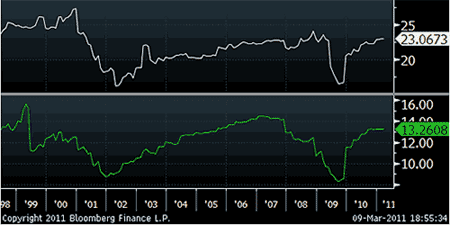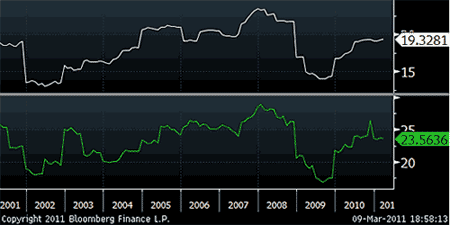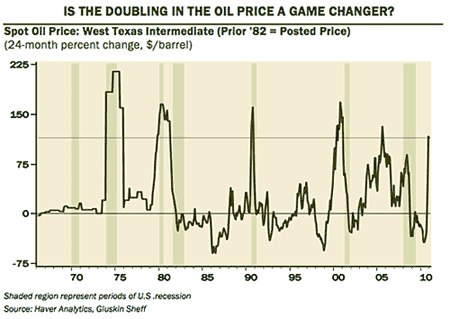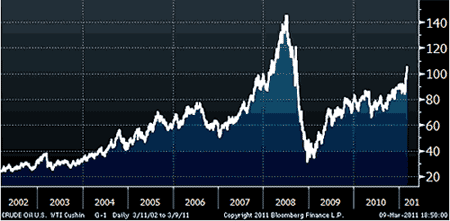The West could struggle while Asian markets boom
Investors have been fleeing emerging markets wholesale for the 'safe havens' of the West. But this may be a mistake. With developed and emerging markets at different points in the business cycle, a mix of Western blue-chips and Asian small-caps could give you the ideal portfolio, says Cris Sholto Heaton.

Investors have been fleeing emerging markets for 'safe havens' indiscriminately of late. But they've been seeking a strange sort of safety. They certainly don't seem to be seeking out the most dependable assets judging by recent performance.
In the US, the Russell 2000 benchmark for smaller caps has fractionally beaten the S&P 500 this year, by 5% to 4.85%. The S&P 'low quality' index has beaten its 'high quality' sibling by 5.7% to 3.7%.
And dodgier debt still seems to be outperforming safer income; the Merrill Lynch High Yield Master II Index of below-investment grade bonds is up 2.13%, against a 0.17% rise in same provider's index for A-BBB investment grade issuers.
MoneyWeek
Subscribe to MoneyWeek today and get your first six magazine issues absolutely FREE

Sign up to Money Morning
Don't miss the latest investment and personal finances news, market analysis, plus money-saving tips with our free twice-daily newsletter
Don't miss the latest investment and personal finances news, market analysis, plus money-saving tips with our free twice-daily newsletter
Two things strike me about this. First, a lot of what we see as a fear trade might in fact just be investors chasing momentum ie whatever happens to be going up. Developed markets have had a few good months, so the hot money has swung into them and out of emerging markets.
And secondly, this might actually be exactly the wrong thing to do if we take a closer look at what's going on in the economy
Where are we in the business cycle?
I was reading Simon Caufield's True Value newsletter this week, in which he talked about when we might expect the next downturn. Let me quote him quickly, and then explain what I see as a complication.
"History shows markets follow a six-to-seven year cycle. For example, they peaked in both 2000 and 2007. And they bottomed in 2003 and 2009. It would be foolhardy to rely on stock market cycles alone. But it would also be odd if the stock market topped out only two years since the last bottom.
"But here's the problem. Company profit margins are very high. That's odd for the early stages of economic recovery. Normally margins peak just before the next downturn. Bulls believe that the recession showed companies how they could get by with permanently lower costs. If so, current margins might be sustainable. If not, markets are overvalued based on long-term average profit margins.
"You can make a similar argument about commodities. Normally prices rise towards the end of an economic cycle. That's when resource shortages normally show up. But this time they're rising whilst most economists say we're in the early stages of recovery. It's a warning that this may be a shorter cycle than normal. I suspect the stock market will reach a peak before 2013."
(Incidentally, if you're not familiar with Simon's value investing letter, I'd highly recommend taking a look at it call our customer services team on 020 7633 3780 for more information. Often thought-provoking, it's one of the two MoneyWeek newsletters that I read most frequently, along with Tim Price's asset allocation letter, The Price Report.)
From the point of view of a developed market investor, I completely agree with Simon. But looking at it from an emerging markets perspective, the story is more complicated.
S&P profit margins are high
First, let's take a look at the point about profit margins. As already mentioned, profitability for markets such as the S&P 500 are back almost to their pre-crisis peaks (see chart below the white line is return on equity and the green line is after-tax profit margin).

This is a much stronger recovery than most of us expected back in 2009. In fact, it seems at odds with the weakness of most developed economies. The same pattern is noticeable for the FTSE 100, although perhaps less so in France and Germany where margins haven't rebounded as strongly.
What's the explanation? I see two obvious possibilities. First, companies have cut costs aggressively, a process helped by weak labour markets. Secondly, many are highly international businesses and have benefited from strong demand in emerging markets.
but emerging market margins aren't
However, the picture in emerging markets is rather different. The chart below shows the same figures for the MSCI Asia ex Japan. Profitability has rebounded well but it's still some way off the pre-crisis highs. (Again, white is return on equity, green is after-tax profit margin.)

So while margins in the UK and US are consistent with us being relatively well-advanced in the cycle, those in emerging markets suggest we're still only in mid-cycle beyond the recovery but not yet approaching a turndown.
Will the oil price scupper the recovery?
What about commodity prices? I'll focus on oil. The chart below from David Rosenberg of Gluskin Sheff shows how a strong rise in oil prices has usually preceded a recession. As ever, correlation does not automatically imply causation, but it's an interesting relationship to think about. Does the recent strong rise suggest that another recession will be upon us sooner rather than later?

Well, let's think briefly about why oil prices rise sharply. There are two fundamental reasons. One is much stronger than expected demand (a demand shock). The other is an interruption to supply (a supply shock).
On top of this, of course, it seems that speculation also plays a part in commodity prices. There is a lot of debate over how much speculation matters personally, I think the effects can be substantial. However, I also think that speculation can only accentuate the fundamentals; it can't create and sustain higher or lower prices by itself for any length of time.
Anyway, if we look back to the 1970s, prices rose mostly as a result of supply shocks. Specific incidents included the oil embargo of 1973-74 and the Iranian revolution of 1979. There was also a general trend for Opec countries to nationalise production and use their cartel power to assert prices.
These shocks were very painful for oil consumers. So it's little surprise that the spiralling price of a key raw material was rapidly followed by recessions. And the 1970s was a troubled time economically. Poor monetary and fiscal policies let inflation get out of control, so it's no surprise that the underlying economy was in no shape to deal with nasty surprises.
The greatemerging marketsdemand shock
At the other end of the extreme, what about the middle of the last decade? The chart again shows a very strong rise, which was not accompanied by any recession. Indeed, the global economy looked in great shape. That optimism was clearly misplaced, as the financial crisis showed, but it's very clear that growth continued uninterrupted.
The difference is that this was a demand shock. The world economy was expanding faster, especially the emerging markets. Meanwhile several lean years of investment in new capacity meant that supply struggled to keep up with demand, especially in sweet (low sulphur), light (less viscous) crudes. Sour (high sulphur), heavy (more viscous) crudes were in better supply, but there was a shortage of capacity to refine these.
The chart below makes this clear. Oil prices rose by over 200% between the start of 2003 and the end of 2007. There were some supply issues such as Iraq and the final move to almost $150/barrel in 2008 was probably down to speculation, aided by the Fed's ultra-easy monetary policy. But the story of 2003-2007 was mostly one of robust demand.

If you'd asked in 2003 what $80/barrel oil would do to the world economy, predictions would have been much more bearish than reality turned out. As it was, everything carried on much as before, at least until the financial system imploded.
So simplifying a bit, demand shocks and supply shocks have very different effects. Supply shocks come from without they damage the economy. Demand shocks come from within they reflect a strong economy.
What's the situation today? Well, it's hard to make the case that most developed economies are strong. Growth is below par, unemployment is high and debt levels are troubling. We certainly wouldn't expect them to be causing a demand shock in oil prices.
But emerging markets still seem in good shape. So it's entirely reasonable that recent strong oil prices except the latest spike, which may just be speculation driven by the Middle East situation are just a continuation of the recent trend. Strong growth and greater oil intensity in these economies has created a demand shock.
Balance your portfolio to match the outlook
So depending on how you look at it, you can come to two different conclusions about where we are in the economic cycle. In developed markets, high profit margins plus a feeling that oil prices are getting into painful territory suggest that we are fairly well advanced in the cycle.
But in emerging markets, margins suggest that we are still mid-cycle. Oil prices of $80-100/barrel, while not pleasant, are probably tolerable if they are ultimately based on strong demand. However, the fact that these economies can tolerate it and have no reason to curb demand will keep prices high and increase the inflationary pressure on developed markets.
So what investment conclusions might we draw from this? Well, if margins are already at a late-cycle stage in the developed world and emerging demand means no respite from oil prices, then the place to be in developed markets is probably in high quality, internationally focused companies.
By this, I mean firms such as Coca-Cola, Microsoft, Johnson & Johnson, GlaxoSmithKline and Unilever, many of which look relatively cheap. Most trade on low-teens p/es and yields of around 3% valuations not seen for 15 years, except during the 2008 panic. They are well-placed to deal with any problems. If someone gave me the option of only owning US Treasuries or only owning Johnson & Johnson, I know which I'd choose.
By contrast, more speculative, lower quality and purely domestic businesses are more likely to be approaching peak profit margins, will struggle more with input inflation and won't benefit from strong demand in the part of the world that's driving oil prices. These shares still seem overvalued to me and are the main reason why developed world markets still aren't cheap overall.
On the other hand, if emerging economies are still in the middle of the cycle and demand is still robust, firms should be able to deal with these pressures much better and still see further profit growth. So there's no particular need to look for blue chip investments here. (Indeed, while I may be an emerging markets enthusiast, I'm not sure that any EM companies can yet be thought of as blue chip.)
So it still seems sound to include some riskier, smaller firms through funds such as Scottish Oriental Smaller Companies (LN:SST), Aberdeen Asian Smaller Companies (LN:AAS) and the iShares MSCI Far East ex-Japan Small Cap ETF (LN:ISFE), as I've previously argued here for different reasons.
Obviously, the idea that we might want to take in risk in EMs while reducing it in the developed world seems counterintuitive at first. But this kind of allocation seems to be part of a sensible structure. You have a core of very solid, dividend-paying companies in the form of high-quality multinationals. At the other extreme, you're taking on riskier, growth exposure through emerging markets.
Throw in some real assets eg some gold, firms that hold agricultural land and timber, select prime property, infrastructure. Add some bonds, although value here is hard to find for those making larger investments, I continue to like Stratton Street's New Capital Wealthy Nations Bond Fund and perhaps a convertible bond fund. And you have a fairly prudently balanced portfolio in my view.
True Value and The Price Report are regulated products issued by MoneyWeek Ltd
Get the latest financial news, insights and expert analysis from our award-winning MoneyWeek team, to help you understand what really matters when it comes to your finances.
Cris Sholto Heaton is an investment analyst and writer who has been contributing to MoneyWeek since 2006 and was managing editor of the magazine between 2016 and 2018. He is especially interested in international investing, believing many investors still focus too much on their home markets and that it pays to take advantage of all the opportunities the world offers. He often writes about Asian equities, international income and global asset allocation.
Cris began his career in financial services consultancy at PwC and Lane Clark & Peacock, before an abrupt change of direction into oil, gas and energy at Petroleum Economist and Platts and subsequently into investment research and writing. In addition to his articles for MoneyWeek, he also works with a number of asset managers, consultancies and financial information providers.
He holds the Chartered Financial Analyst designation and the Investment Management Certificate, as well as degrees in finance and mathematics. He has also studied acting, film-making and photography, and strongly suspects that an awareness of what makes a compelling story is just as important for understanding markets as any amount of qualifications.
-
 MoneyWeek news quiz: How much can you win in Premium Bonds?
MoneyWeek news quiz: How much can you win in Premium Bonds?Quiz Premium Bonds, ChatGPT, and the start of the festive season all made headlines this week. How closely were you following the news?
-
 Salary sacrifice pensions cap: 3.3 million workers to be hit by contribution limits
Salary sacrifice pensions cap: 3.3 million workers to be hit by contribution limitsThe government has revealed further details of its controversial cap on pension contributions through salary sacrifice. Here is how the changes could affect you
